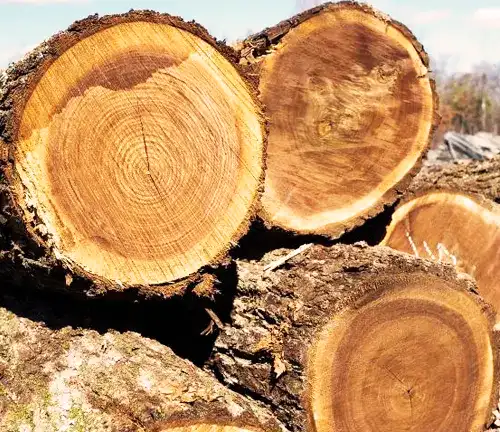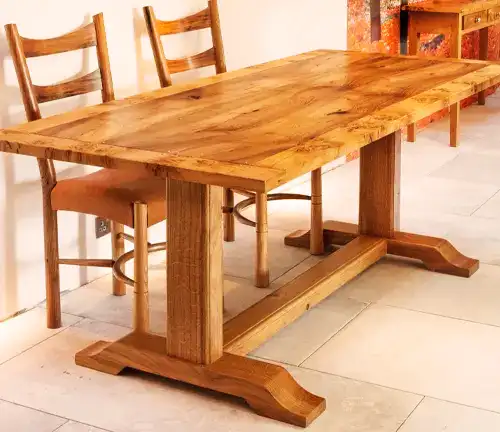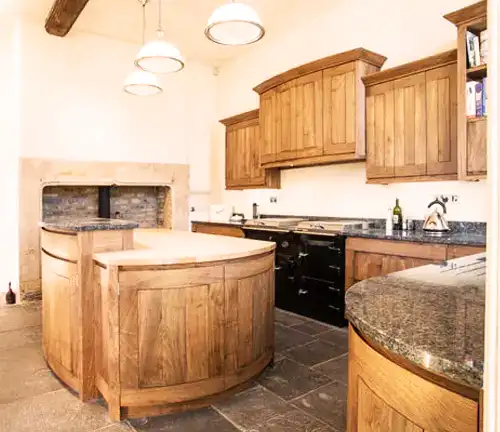English Walnut Lumber
- September 4, 2023
- 0 comment

English Walnut lumber, originating from the regal Juglans regia tree, emerges as a prized gem in the realm of woodworking, captivating artisans and woodworkers alike with its multifaceted appeal. With a color spectrum ranging from a soft, pale brown to a rich, indulgent chocolate, the wood emanates warmth and sophistication, creating a visual allure that is second to none. Its fine, straight grain and uniform texture contribute to its reputation as an optimal choice for crafting high-end furniture and intricate decorative pieces, allowing for clean cuts and intricate designs.
Beyond its aesthetic virtues, English Walnut demonstrates a commendable resistance to decay and rot, making it especially suitable for indoor applications. What truly sets this wood apart is its exceptional workability, responding with grace to both hand and machine tools, making it a delight for craftsmen pursuing precision and detail. Adding to the sensory experience, English Walnut carries a mild and pleasing aroma, enhancing the overall woodworking process. Importantly, it proves to be allergy-friendly, catering to a broad spectrum of applications. However, the elegance of English Walnut comes at a cost, reflected in its higher price point, a testament to its desirability.
Sustainability is not compromised, as responsibly sourced English Walnut aligns with environmental considerations, making it a conscious choice for those seeking both beauty and eco-friendliness. In common use, it finds its place in crafting high-end furniture, veneers, cabinetry, gunstocks, and musical instruments, embodying the harmonious blend of aesthetics and functionality that defines the essence of fine woodworking.
| Property | Value |
|---|---|
| Common Name(s) | English Walnut |
| Scientific Name | Juglans regia |
| Distribution | Southeast Europe, Western Asia |
| Tree Size | Up to 100 ft (30 m) in height |
| Average Dried Weight | 41 lbs/ft³ (655 kg/m³) |
| Specific Gravity | 0.66 |
| Janka Hardness | 1,030 lbf (4,580 N) |
| Modulus of Rupture | 14,300 lbf/in² (98.6 MPa) |
| Elastic Modulus | 1,620,000 lbf/in² (11.17 GPa) |
| Crushing Strength | 7,570 lbf/in² (52.2 MPa) |
| Shrinkage | Radial: 4.8%, Tangential: 7.6%, Volumetric: 13.2% |
Color/Appearances

English Walnut lumber, sourced from the regal Juglans regia tree, exhibits a captivating range of colors, from soft pale browns to deep, luxurious chocolates. This inherent richness grants the wood an undeniable warmth and sophistication, making it a coveted choice for those who appreciate the aesthetics of fine woodworking.
Grain/Texture
One of the defining features of English Walnut is its fine, straight grain and uniform texture. This quality not only enhances its visual appeal but also positions it as an ideal material for crafting detailed and intricate woodworking projects. The smooth, consistent grain allows for clean cuts and impeccable designs, making it a top pick among artisans and woodworkers.

Rot Resistance
English Walnut is moderately durable and exhibits good resistance to decay, though it might not be as durable as some other hardwoods. Proper finishing and maintenance can extend its lifespan.
Workability

What sets English Walnut apart is its exceptional workability. Whether worked with hand tools or machines, this wood responds with grace, allowing craftsmen to achieve precision and finesse in their creations. Its good gluing and finishing properties make it a joy to work with, further solidifying its status as a favorite among woodworkers.
Odor
The mild and pleasant aroma emitted by English Walnut during cutting or working adds an extra sensory dimension to the crafting process. This subtle fragrance enhances the overall experience for woodworkers, creating an environment that is both visually and olfactory appealing.
Allergies/Toxicity
English Walnut is known for being generally allergy-friendly, posing a minimal risk for those with wood allergies. This characteristic expands its versatility, making it a safe and suitable choice for a broad spectrum of applications, including furniture and interior finishes.
Pricing/Availability
The allure of English Walnut comes at a cost, as it typically commands a higher price compared to more common hardwoods. Its availability can vary, and obtaining large, clear boards may require careful sourcing. However, the investment often aligns with the wood’s exceptional beauty, workability, and the timeless elegance it imparts to finished products.
Sustainability
In the context of sustainable woodworking practices, English Walnut can align with environmental consciousness when sourced responsibly. While not as prevalent as some hardwoods, conscientious harvesting and management can contribute to the sustainable use of this elegant wood, making it a responsible choice for eco-minded craftsmen.
Common Uses
English Walnut lumber is prized for its versatility, finding its way into various high-end applications in woodworking. Its exquisite color and fine grain make it a preferred choice for crafting elegant furniture and detailed cabinetry. The wood’s workability and durability lend themselves well to the creation of gunstocks, combining functionality with aesthetic appeal. Furthermore, its acoustic properties and visual allure make it a favored material in the crafting of musical instruments. Beyond being a construction material, English Walnut stands as a testament to the harmonious blend of artistry and functionality across a spectrum of applications.


Frequently Asked Questions (FAQs)
- Can I plant an English Walnut tree in my backyard?
Yes, you can plant an English Walnut tree if you have the appropriate climate and space. They require well-drained soil and a sunny location. - Is English Walnut suitable for outdoor furniture?
While English Walnut is beautiful, it’s not as durable as some other hardwoods. It might be better suited for indoor furniture or pieces that are protected from the elements. - Are English Walnuts the same as black walnuts?
No, English Walnuts (Juglans regia) and Black Walnuts (Juglans nigra) are different species. English Walnuts have a milder flavor and thinner shells compared to the more intense-flavored Black Walnuts. - Is English Walnut wood easy to carve?
Yes, English Walnut’s fine to medium texture and relatively consistent grain make it well-suited for carving intricate details. - Can English Walnut wood be stained?
Yes, English Walnut can take stains and finishes well, enhancing its natural beauty while allowing customization of its color.
“We’re eager to learn from you! Feel free to discuss your personal encounters and impressions with English Walnut Lumber in the comment section. Your valuable insights might offer fellow craftsmen essential guidance while making informed choices about this remarkable wood!”







Leave your comment